#atlantogenata
Text
Snoot

(giant anteater, https://www.flickr.com/photos/ekilby/27990365748)

(elephant shrew, https://i.pinimg.com/736x/9b/87/65/9b876533420fefdbaf0b26812a714011--planet-earth-funny-animals.jpg)

(African elephant, https://images.fineartamerica.com/images-medium-large-5/side-view-of-old-elephant-loxodonta-john-bryant.jpg)
fun fact: anteaters, elephants and elephant shews are all in a clade called Atlantogenata. It also contains sloths, armadillos and tenrecs.
12 notes
·
View notes
Text

African bush elephant (Loxodonta africana)
Photo by Andrew Rice
#african bush elephant#african elephant#elephant#loxodonta africana#loxodonta#elephantidae#proboscidea#tethytheria#paenungulata#afrotheria#atlantogenata#eutheria#mammalia#tetrapoda#vertebrata#chordata
13K notes
·
View notes
Text
Mammuthus

South African Mammoth by Scott Reid
Etymology: Earth-Horn
First Described By: Brookes, 1828
Classification: Biota, Archaea, Proteoarchaeota, Asgardarchaeota, Eukaryota, Neokaryota, Scotokaryota Opimoda, Podiata, Amorphea, Obazoa, Opisthokonta, Holozoa, Filozoa, Choanozoa, Animalia, Eumetazoa, Parahoxozoa, Bilateria, Nephrozoa, Deuterostomia, Chordata, Olfactores, Vertebrata, Craniata, Gnathostomata, Eugnathostomata, Osteichthyes, Sarcopterygii, Rhipidistia, Tetrapodomorpha, Eotetrapodiformes, Elpistostegalia, Stegocephalia, Tetrapoda, Reptiliomorpha, Amniota, Synapsida, Eupelycosauria, Sphenacodontia, Sphenacodontoidea, Therapsida, Eutherapsida, Neotherapsida, Theriodontia, Eutheriodontia, Cynodontia, Epicynodontia, Eucynodontia, Probainognathia, Chiniquodontoidea, Prozostrodontia, Mammaliaformes, Mammalia, Theriiformes, Holotheria, Trechnotheria, Cladotheria, Zatheria, Tribosphenida, Theria, Eutheria, Placentalia, Atlantogenata, Afrotheria, Paenungulata, Tethytheria, Proboscidea, Elephantiformes, Elephantimorpha, Elephantida, Elephantoidea, Elephantidae, Elephantinae, Elephantini, Elephantina
Referred Species: M. africanavus (African Mammoth), M. columbi (Columbian Mammoth), M. creticus (Cretan Dwarf Mammoth), M. exilis (Pygmy Mammoth), M. lamarmorai (Sardinian Pygmy Mammoth), M. meridionalis (Southern Mammoth), M. primigenius (Woolly Mammoth), M. rumanus (Romanian Mammoth), M. subplanifrons (South African Mammoth), M. trogontherii (Steppe Mammoth)
Status: Extinct
Time and Place: Mammoths have been around from 5 million years ago, until 3,700 years ago (give or take a few hundred years)


Mammoths are known from throughout North America and Afroeurasia
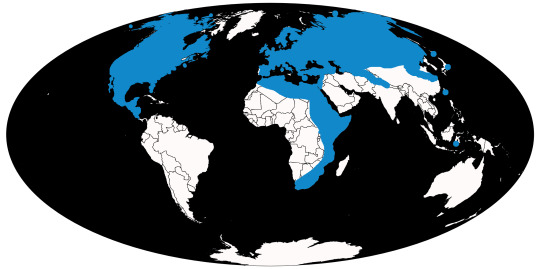
Physical Description: Mammoths were (mostly) large, elephanty creatures - with big bodies, long limbs, trunks, small tails, and tusks coming out of their mouths in both sexes. Most were about as large as Asian elephants, though some may have exceeded 12 tonnes. Still, there were dwarf species as well, which were quite small - some not even breaking 1000 kilograms. They grew their first tusks at the age of six months, which were then replaced at eighteen months by the permanent set. These would then grow at about 2.5 to 15.2 centimeters per year. Their teeth were distinctive - with rows of ridges that looked almost like the body of an arthropod (rather than the more flat surface seen in contemporary mastodons).

By FunkMonk, in the Public Domain
The mammoths had small ears, primarily due to the need to conserve body heat in most cases, unlike modern elephants which have larger ears with which to let off excess body heat. They had wide feet, splayed apart to help hold up their bodies. The males usually would grow larger than the females, based on the shape of the pelvis in fossils and frozen remains of these mammals. And, though a few species are very hairy - leading to the famed Woolly Mammoth - not all of them were, and many species of this genus were naked, with grey or more beige colored skin, as they lived in drier and warmer environments and needed to let off heat and sweat. Those that were hairy had thick layers of fur covering their entire bodies, even shorter tails to reduce frostbite, and thick layers of fat for keeping warm. A few species - notably, the Woolly Mammoth - had very brown, fluffy fur. Finally Mammoths, like modern elephants, were extremely intelligent animals, and had the brain and head size to match.

Woolly Mammoth by Mauricio Antón, CC BY 2.5
Diet: Mammoth diet varied from species to species and location to location of mammoths, though they were, overall, herbivores. Some mainly grazed on things like cacti leaves, trees, and shrubs; others, herbs, grasses, and shrubs; still more, forbs, rather than grass. Sometimes, babies that were no longer drinking milk would eat the poop of adults, like modern elephants, as they could not chew properly on plant material yet. This would also lead to feeding on fungi associated with poop, in addition to the plant material present.
Behavior: Mammoths were, in general, herding animals, much like modern elephants - in fact, it is theorized that they probably had social structures very similar to their living relatives. They had females living in herds, headed by a matriarch, that was the source of wisdom for the whole heard; meanwhile, the males would live alone or form loose groups of convenience when the situation arose. These herds would, oftentimes, migrate from region to region based on weather patterns and seasonal change. They could form herds of thousands of individuals of a variety of ages, with the adorable image of juveniles and young running to keep up with the strides of the much larger adults.
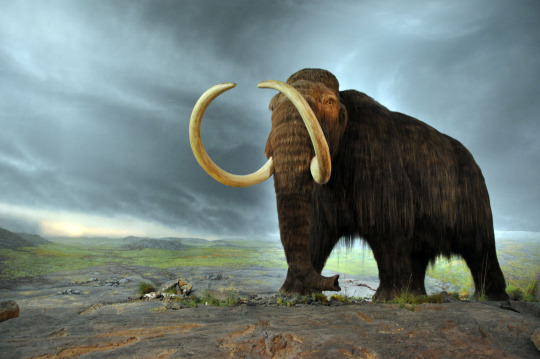
Woolly Mammoth by Flying Puffin, CC BY-SA 2.0
Mammoths, like modern elephants, mainly interacted with their environments with their trunks, which were essentially fifth limbs for these animals. They grabbed objects in their environments and talked to each other through the movement of their trunks. The trunks were also used for grabbing food in a lot of situations, pulling up coarse tundra grass and other food items and brought to the mouth, where it would then be chewed with the trough, specialized teeth. They used their tusks for defense from predators, though this wasn’t very helpful for the juveniles, who did not have extensive tusks. The mammoths also fought each other with their tusks, especially males, who would interlock the tusks and even break them while fighting for mates. They could also use the tusks to strip off bark and gather up food, even by digging in the dirt for food.
Ecosystem: Mammoths lived in a wide variety of habitats overall, though of course these differed from species to species. They lived across savanna and desert, steppe and tundra, grassland and scrubland, and even in sparse forest and higher elevations. As for predators, Mammoths were heavily at risk from predators such as lions, sabre-toothed cats, various types of wolves and other dogs, and of course, humans - which are probably the reason Mammoths are extinct today.

Cave Art from PalaeoAmerica, in the Public Domain, depicting two Columbian Mammoths (with a bison drawn over the right one)

Kapova Cave, in the Public Domain
Other: How did Mammoths go extinct? Apart from earlier species, the answer seems to be a combination of climate change and human activity. Multiple species - especially the Columbian and Woolly Mammoths - are known to have been hunted by humans, and cave drawings depict this activity for both of these species. This combination had a terrible effect on all species of mammoths - rising sea levels, with wildfires, and human hunting lead to the extinction of the Pygmy Mammoth, despite not being as large and specialized as those more iconic, giant species of mammoths elsewhere. Habitat shrinkage did not help with Mammoth populations; but human activity definitely contributed, as many populations of mammoth were heavily impacted by human activity. Prior to this, there was extensive genomic meltdown, as DNA diversity went into heavy decline for the past few thousand years. Isolated populations of mammoths - such as those on islands - showed the most extreme decline as the climate changed and humans became more common. The final death knell came from population fragmentation - with mammoths no longer having overlapping ranges, isolated populations were more susceptible to these rapid changes, and each subsequently went extinct due to climate change and human activity (with different causes being more or less important depending on the population in question).

Steppe Mammoth by Titus 322, in the Public Domain
Species Differences: There are 10 species of mammoth, each very distinct from the others, and each occupying unique environments and locations. Some are older than the others, as well.
The oldest species, M. subplanifrons, or the South African Mammoth, appeared about 5 million years ago - at the very beginning of the Pliocene. It spread from South Africa to the East African region, where it became most common in Ethiopia (funnily enough, the same time and location as human evolution, really). They were very similar to later mammoths, having spirally twisting tusks and large size - weighing up to 9 tonnes. They went extinct within the Early Pliocene and, given that they lived in Africa, were probably not very hairy as far as mammoths go; living mainly on savannas and other habitats that we see modern African Elephants on today.

African Mammoth by Apokryltaros, CC BY 2.5
The second oldest species, M. africanavus, the African Mammoths, lived from the Late Pliocene (about 3 million years ago) through the earliest part of the Pleistocene, about 1.65 million years ago. These two early species in Africa point to an African origin for the Mammoths. It has been found in Chad, Libya, Morocco, and Tunisia - showing the northern migration of Mammoths in their early evolution. They had very widely diverging tusks, much more so than other mammoths.
The next in the group, M. rumanus, the Romanian Mammoth, is one of our earliest examples of a Mammoth that spread to Europe - having been found in the late Pliocene of the UK and Romania. Being a very short lived and poorly known species, it is difficult to know much about it, though it does point to Mammoths migrating out of Africa through the Levant region, up to Eurasia from there. It’s possible that the Romanian Mammoth helps to show more about the dispersal of this genus through Eurasia as the Ice Age began in the Pleistocene.
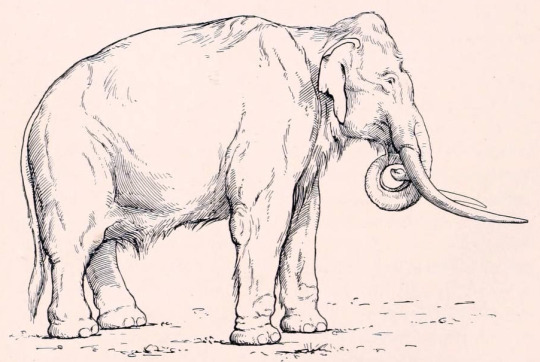
Southern Mammoth by Erwin S. Christman, in the Public DOmain
The Southern Mammoth, M. meridionalis, lived from the end of the Pliocene through the beginnings of the Pleistocene, and is known from Europe through Central Asia. It is known from many remains, which pinpoint that it may have been very closely related to the African Mammoth, though currently it is hypothesized that the South African Mammoth was the ancestor of all other forms. The Southern Mammoth grew to be about 4 meters tall and weighed 10 tonnes, making it one of the largest of the group. It had very robust, twisted tusks like other mammoths. It lived, generally, during a more mild time of the Ice Age, feeding mainly on deciduous trees and living in grassy, open habitats with small groves here and there. It was a browser, feeding mainly on higher level foliage.
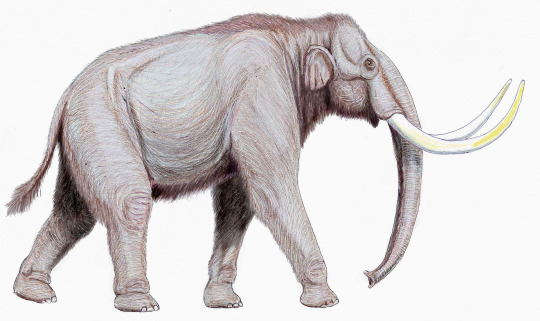
Steppe Mammoth by Dmitry Bogdanov, CC BY 3.0
All other Mammoths lived from the Pleistocene on, with some making it into the Holocene (and subsequently going extinct during the Pleistocene-Holocene Megafaunal Extinctions). The Steppe Mammoth is the next in our temporal sequence, M. trogontherii, known from Siberia in the middle of the Pleistocene - the first stage in the evolution of steppe and tundra mammoths during the glacial periods of the time. It probably had fur on most of its body - shorter than that of the Woolly Mammoth, but not by much. It had a short skull and small jaw compared to other mammoths, and the males had tusks with tips that could grow extra long and curved. They grew up to 4 meters tall and around 10 tonnes in weight. It is known mainly from fossilized teeth, with skeletons being rare, though some complete skeletons have been excavated in northern parts of the UK and siberia. It probably ate mainly shrub plants and tundra forbs.

Columbian Mammoth by Dmitry Bogdanov, CC BY-SA 4.0
The next species of Mammoth to evolve was the famed Columbian Mammoth, of the mid Pleistocene through Early Holocene of North America. Though it’s range was next to that of the Woolly Mammoth, they clearly divided North America between the two, with Woolly taking the northern half of the continent, and the Columbian mammoth taking the southern half. The Columbian Mammoth is known from a lot of fossils, across a variety of localities, and show the initial spread into North America by mammoths in an earlier in-between period of the Ice Age than the expansion of Woolly Mammoths later. It evolved from the Steppe Mammoth, which migrated across the Bering Strait into North America, down corridors available between glaciers through to the bulk of the area that would be the continental United States. The Columbian Mammoth grew to 4 meters in height and 10 tonnes in weight, making it larger than the Woolly Mammoth and the African Elephant. It also had fairly primitive teeth compared to other mammoths. It had tusks directed farther apart than those of other mammoths, and it had a longer tail. Since it lived in warmer habitats, it lacked a lot of the adaptations for the cold, and probably didn’t have much in the way of hair for keeping warm. Its tusks were excessively long, especially compared to modern elephants.
Many Columbian Mammoths are found in Elephant Graveyard fossil deposits, indicating areas where the bones of individuals would accumulate due to the movement of water. Additionally, many fossil remains are found in tar pit accumulations, in addition to sinkholes and other natural traps. Most fossils found in these sites are actually males, which were more likely to put themselves in danger than the females - lured to these holes by warm water and vegetation at the edges. These elephants would have needed to spend most of their day foraging, using their trunks to pull up grass, flowers, and other types of food. It’s possible that these mammoths could have reached even 80 years in age, growing for most of their lives.
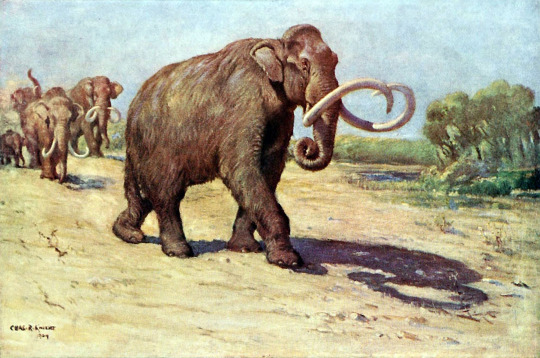
Columbian Mammoth by Charles R. Knight, in the Public Domain
The Cretan Dwarf Mammoth, M. creticus, is one of three diminished species of Mammoths, known from about 700,000 years ago on the island of Crete in the Mediterranean. These mammoths were very small, reaching only 1 meter tall and weighing only 310 kilograms - making it the smallest of the mammoths. It is possible that this animal wasn’t a mammoth at all, but another type of proboscidean; studies are still out on that one. Skulls of this animal may have formed the basis for the Grecian myth of the Cyclops!
The Sardinian Pygmy Mammoth, M. lamarmorai, was another species of small mammoth which evolved about 450,000 years ago, and is known only from the island of Sardinia. It grew about 1.4 meters tall and weighed up to 550 kilograms. It is known from many fossils, but no complete skeletons, mainly along the west coast. It is actually very uncertain what sort of mammoth this species originated from; it seems possible that the Steppe Mammoth colonized Sardinia, and then experienced Island Dwarfism as it was isolated on the island during an in-between period.
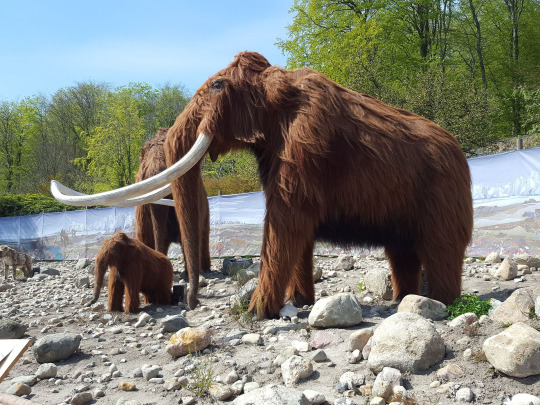
Woolly Mammoth by Honymand, CC BY-SA 4.0
The second to last species of Mammoth to evolve is, indeed, the best known of them all - M. primigenius, the Woolly Mammoth. Woolly Mammoths lived around the Arctic circle, in northern Eurasia and North America. Evolving from the Steppe Mammoth sometime between 400,000 and 150,000 years ago, it lived all the way up until the recent past, about 4,000 years ago - leading to the common fun fact that the Pyramids were built while Mammoths were still alive! Given it’s late position in the fossil record and extreme numbers during the last ice age, we have so many fossils and frozen remains of this animal that we know much of its life history (and the Woolly Mammoth remains one of the most controversial examples of something we might actually bring back through de-extinction). Because of this abundance of remains, we know a lot about its life appearance and life history - in fact, it’s the prehistoric animal with the best known appearance.
Woolly Mammoths were - as the name suggests - woolly, covered in layers of fur all over their bodies which was brown in color, as well as very thick layers of fat, very small ears and short tails, and flaps of skin covering orifices to keep them warm. The mammoths had oil glands in their skin, which secreted into their hair and helped the hair in repelling water, and gave the hair a glossy sheen. There was long, coarse guard hair on the outer layer, covering curly under-wool underneath. Interestingly enough, the Woolly Mammoth also had some weird physical characteristics not related to the warmth, such as a very high, domed head, and a sloping back with a shoulder hump. These were more present in adults, and not visible in juveniles. Their tusks were asymmetrical and extremely varied, and weirdly enough, most of the length of the tusks was inside the mouth. They had four molars at a time, used for chewing very tough vegetation.
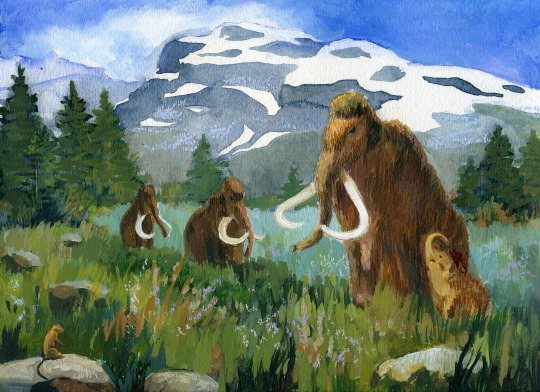
Woolly Mammoths by Kira Sokolvskaia, CC BY-SA 3.0
The Woolly Mammoth was the most specialized elephant to ever live, with extreme amounts of fat stored for warmth and when food was unavailable; their molars grew more quickly than in modern elephants; and their fur was so thick it was as though they wore mittens all over their bodies. They had differences in circadian rhythm clocks from living elephants in order to deal with extreme variation in daylight levels, and its proteins were less sensitive to heat. They had about 1.4 million differences in DNA compared to their closest living relatives, the Asian Elephants. They fed mainly on herbs, small flowering plants, shrubs, and mosses, and even fungus and poop from each other - not just the young, but the adults would do this too in times of food scarcity. They probably could reach up to 60 years of age, and they grew past adulthood - like living elephants.
The males also would go into musth - a period of extreme aggressiveness - during the breeding season, like living elephants today. They produced oil with glands that moved a smell associated with musth all over their fur, signaling to female mammoths they were ready to go, and to male mammoths to leave them alone. The breeding season was typically in the summer through the beginning of fall. The mammoths gave birth during the spring and summer, after a gestation period of nearly two years. While many reached older age and adulthood, bone disease was a very common cause of death for these mammals, as well as parasitic animals and infections after poorly healed injuries. Still, many were murdered by humans, and mammoth bits are used heavily in human society - for food, warmth, and art, with ivory from mammoths used in sculptures by early humans.
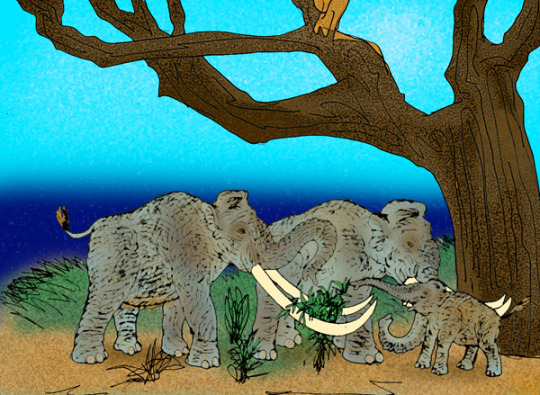
Pygmy Mammoth by Apokryltaros, CC BY 2.5
Finally, Pygmy Mammoths - M. exilis - were the last species to evolve, evolving approximately 60,000 years ago; still, it didn’t live as long as the Woolly Mammoth, dying out about 11,000 years ago, right at the beginning of the Holocene. The third case of insular dwarfism in the Mammoths, it grew to about 1.72 meters tall at the shoulders and 760 kilograms in weight. It evolved from the giant Columbian Mammoth, as well, making this all the more impressive. It is known from the Channel Islands along California, where Columbian Mammoths presumably reached via land bridges during some glacial period of the Ice Age. Possibly, they also swam there in search of food and escaping the large predators of the mainland such as Smilodon and the American Lion. It thrived across a variety of ecosystems, including plateaus, dunes, grasslands, forests, and even steppe-tundras.
~ By Meig Dickson
Sources under the Cut
https://en.wikipedia.org/wiki/Mammoth
https://en.wikipedia.org/wiki/African_mammoth
https://en.wikipedia.org/wiki/Columbian_mammoth
https://en.wikipedia.org/wiki/Mammuthus_creticus
https://en.wikipedia.org/wiki/Pygmy_mammoth
https://en.wikipedia.org/wiki/Mammuthus_lamarmorai
https://en.wikipedia.org/wiki/Mammuthus_meridionalis
https://en.wikipedia.org/wiki/Woolly_mammoth
https://en.wikipedia.org/wiki/Mammuthus_rumanus
https://en.wikipedia.org/wiki/Mammuthus_subplanifrons
https://en.wikipedia.org/wiki/Steppe_mammoth
#Mammuthus#Mammoth#Woolly Mammoth#Not a Dinosaur#Mammal#April Fool's#Prehistoric Life#Prehisotry#Paleontology#North America#Eurasia#Africa#Neogene#Quaternary#Herbivore#Ice Age#prehistory#biology#science#nature#factfile
861 notes
·
View notes
Note
Sorry for this little rant but: It always fucks me up a bit that cetaceans are artiodactyls. Like, I understand the reasoning behind; I understand that their ancestors were ungulates so they are too, but I just can't fully wrap my head around it and my monkey brain wants them to belong to Ferae or Atlantogenata instead because external morphology
That’s the glory of evolution!
11 notes
·
View notes
Photo

Silky anteater (Cyclopes sp.)
Photo by Paula Senra
#unidentifiable#silky anteater#pygmy anteater#cyclopes#cyclopedidae#vermilingua#pilosa#xenarthra#atlantogenata#eutheria#mammalia#tetrapoda#vertebrata#chordata
2K notes
·
View notes
Text

Aardvark (Oryctaropus afer)
Photo by Johan Van Zyl
#aardvark#oryctaropus afer#oryctaropus#orycteropodidae#tubulidentata#afrotheria#atlantogenata#eutheria#mammalia#tetrapoda#vertebrata#chordata
156 notes
·
View notes
Photo

Giant anteater (Myrmecophaga tridactyla)
Photo by Andreas Volz
#giant anteater#myrmecophaga tridactyla#myrmecophaga#myrmecophagidae#vermilingua#pilosa#xenarthra#atlantogenata#eutheria#mammalia#tetrapoda#vertebrata#chordata
82 notes
·
View notes
Photo

African forest elephant (Loxodonta cyclotis)
Photo by Fabrice Stoger
#african forest elephant#african elephant#elephant#loxodonta cyclotis#loxodonta#elephantidae#proboscidea#tethytheria#paenungulata#afrotheria#atlantogenata#eutheria#mammalia#tetrapoda#vertebrata#chordata
63 notes
·
View notes
Photo

Florida manatee (Trichechus manatus latirostris)
Photo by Jana & Michal Tyl
#ok... wig#florida manatee#west indian manatee#american manatee#manatee#sea cow#trichechus manatus latirostris#trichechus manatus#trichechus#trichechinae#trichechidae#sirenia#tethytheria#paenungulata#afrotheria#atlantogenata#eutheria#mammalia#tetrapoda#vertebrata#chordata
105 notes
·
View notes
Photo
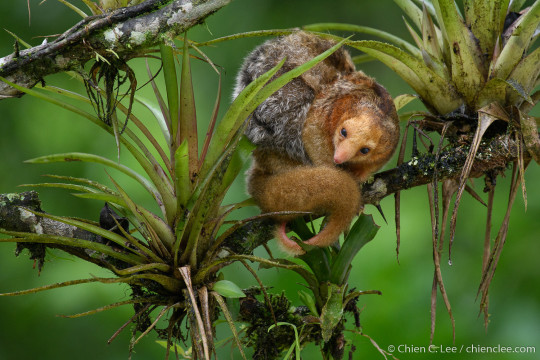
Silky anteater (Cyclopes didactylus)
Photo by Chien Lee
#silky anteater#cyclopes didactylus#cyclopes#cyclopedidae#vermilingua#pilosa#xenarthra#atlantogenata#eutheria#mammalia#tetrapoda#vertebrata#chordata
99 notes
·
View notes
Photo

African bush elephant (Loxodonta africana)
Photo by Fabrice Stoger
#african bush elephant#african elephant#elephant#loxodonta africana#loxodonta#elephantidae#proboscidea#tethytheria#paenungulata#afrotheria#atlantogenata#eutheria#mammalia#tetrapoda#vertebrata#chordata
29 notes
·
View notes
Text

Indian elephant (Elephas maximus indicus)
Photo by Per Andrén
#indian elephant#asiatic elephant#elephant#elephas maximus indicus#elephas maximus#maximus#elephas#elephantidae#proboscidea#tethytheria#paenungulata#afrotheria#atlantogenata#eutheria#mammalia#tetrapoda#vertebrata#chordata
15 notes
·
View notes
Photo

Nine-banded armadillo (Dasypus novemcinctus)
Photo by Barry & Carole Bowden
#nine banded armadillo#armadillo#dasypus novemcinctus#dasypus#dasypodinae#dasypodidae#cingulata#xenarthra#atlantogenata#eutheria#mammalia#tetrapoda#vertebrata#chordata
18 notes
·
View notes
Photo

Brown-throated sloth (Bradypus variegatus)
Photo by Hennie van Heerden
#brown throated sloth#three toed sloth#bradypus variegatus#bradypus#bradypodidae#folivora#pilosa#xenarthra#atlantogenata#eutheria#mammalia#tetrapoda#vertebrata#chordata
22 notes
·
View notes
Photo
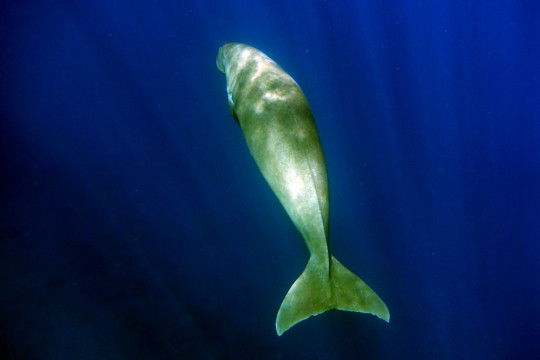
Dugong (Dugong dugon)
Photo by Karsten Kretz
#sea cow#lady of the sea#dugong dugon#dugong#dugonginae#dugongidae#sirenia#tethytheria#afrotheria#atlantogenata#paenungulata#eutheria#mammalia#tetrapoda#vertebrata#chordata
32 notes
·
View notes
Photo
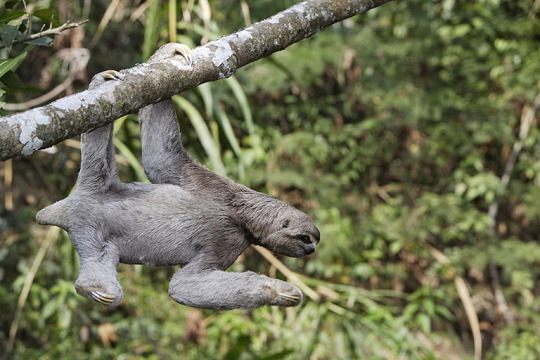
Brown-throated sloth (Bradypus variegatus)
Photo by Sylvain Cordier
#brown throated sloth#three toed sloth#bradypus variegatus#bradypus#bradypodidae#folivora#pilosa#xenarthra#atlantogenata#eutheria#mammalia#tetrapoda#vertebrata#chordata
15 notes
·
View notes